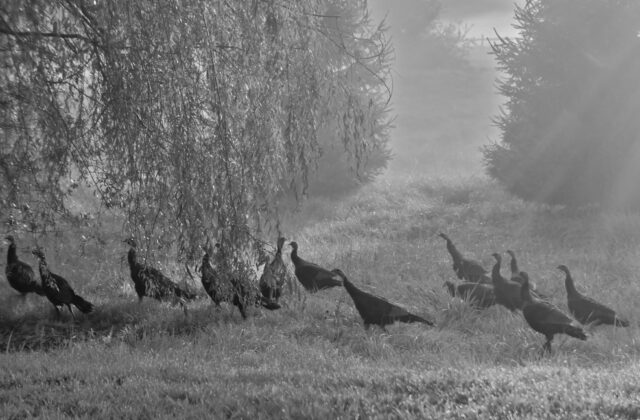Wild Turkey Restoration Has Been Successful in Norfolk
It’s Only Natural
By Jude Mead
Travel any road in Norfolk and you are certain to see a flock of turkeys. The eastern wild turkey is a large, majestic bird with adult males weighing anywhere between 15 and 25 pounds, and adult females weighing between eight and 12 pounds. They look similar in their appearance, but the males have spurs on their legs and a tuft of thick, hair-like feathers called a beard protruding out of their chest.
Wild turkeys were not always abundant in this area. According to Jay Kaplan, the director at Roaring Brook Nature Center, a combination of forest clearing, and severe winters eliminated much of the population at the turn of the century. “The wild turkey was once called ‘the king of the forest bird’ until all the forests were cut down in the late 1800s. The forest is the turkey’s natural habitat. No more forests meant no more turkeys,” said Kaplan.
According to Kaplan there were many attempts at wild turkey restoration, but most were largely unsuccessful until 1975 when the state of Connecticut started to reintroduce them to the area. “When the state started releasing turkeys in many towns throughout Connecticut it helped bring back the turkey population. It took several years, but it was successful.” According to the Department of Energy and Environmental Protection (DEEP), 356 wild turkeys were released in Norfolk and 17 other sites throughout the state. These releases, along with better forest protection practices, helped the turkey population increase and thrive.
Besides mature hardwood and mixed forest areas, wild turkeys can be found in fields, cropland, open pastures and neighborhood backyards and they feed on nuts, acorns, fruits, insects and even salamanders. “Turkeys will eat anything from ordinary bugs to the seeds they find in people’s backyard bird feeders. They can strip the bark off trees with their sharp claws,” said Kaplan.
When turkeys find a habitat that is rich in vegetation, they will settle there, especially if there are trees for them to roost in nearby. “Turkeys have the ability to fly and prefer to sleep on the branches of trees rather than the ground because they are better protected from inclement weather and predators,” Kaplan explained.
Though they are hardy creatures, heavy rain and very cold temperatures affect them negatively. They sometimes need to stay in a tree for a long time before their body can adjust to the weather change. Roosting in trees also protects them from predators. These birds can fly from zero to 55 miles per hour in a few seconds, despite their large size, making it easy for them to escape. “Being able to fly and get away quickly protects them from foxes, bobcats, owls, and coyotes, who find them easy prey and can kill an adult turkey. They also must be aware of hunters in the spring and fall,” said Kaplan.
Smaller predators, including skunks, raccoons, opossums, and snakes attack the turkey eggs or babies. Female turkeys build their nests on the ground at the base of trees or in shrubbery making them easy prey, even though they try to conceal the eggs by covering them with leaves and debris.
Turkeys will fight off predators using the spurs on the back of their legs as a weapon, biting with their beak and ramming them with their large bodies. Few predators, however, can catch a wild turkey. “Turkeys are large birds and can defend themselves. They can also get away by flying and are fast runners,” said Kaplan. They run at speeds of 20 miles an hour and can cover several square miles in a day. They have excellent eyesight and acute hearing. Their average life span in the wild is only three or four years.
Wild turkeys contribute to the ecosystem. They provide food for their predators and affect the plants whose seeds and nuts they eat. As the ecosystem improves, so does the turkey’s future. Today Norfolk has a healthy population of wild turkeys. According to the DEEP, landowners can help to encourage and maintain the state’s population through various wildlife habitat improvements such as creating forest openings away from roads and growing bushes and vines that produce food and cover.
For more in-depth information on the eastern wild turkey, Kaplan recommends reading The World of the Wild Turkey by James C. Lewis.

